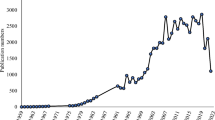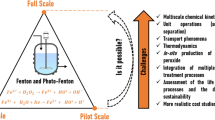Abstract
One-dimensional steady-state models have been developed for the recovery of Pb(II) ions from lead–acid battery recycling plant effluent by simultaneous lead and lead dioxide deposition, including oxygen evolution/reduction and hydrogen evolution as loss reactions. Both monopolar and bipolar reactor with porous graphite electrodes were modelled, as a design aid for predicting spatial distributions of potentials, concentrations, current densities and efficiencies, as well as specific electrical energy consumptions and by-pass currents. Since the industrial effluent contains a large excess of supporting electrolyte (Na2SO4), the electrical migrational contribution to reactant transport rates was neglected and the current density–potential relationship was described by the Butler–Volmer equation, allowing for both kinetic and mass transport control. The models were implemented and the governing equations solved using commercial finite element software (FEMLAB). The effects were investigated of electrolyte velocity, applied cathode potential, dissolved oxygen concentration and inlet Pb(II) ion concentration on single-pass conversion, current efficiency and specific electrical energy consumptions. According to model predictions, de-oxygenation of the inlet process stream was found to be crucial to achieving acceptable (i.e. >0.8) current efficiencies. Bipolar porous electrodes were also determined to be inappropriate for the recovery of Pb(II) from effluents, as the low concentration involved resulted in the predicted fraction of current lost as by-pass current, i.e. current not flowing in and out of the bipolar electrode, to be greater than 90% for the ranges of the variables studied.
Similar content being viewed by others
Abbreviations
- Symbol:
-
Meaning (Units)
- a :
-
Specific surface area of porous electrode m2 m−3
- C i :
-
Concentration of species i mol m−3
- C i,0 :
-
Inlet concentration of species i mol m−3
- D i :
-
Diffusion coefficient of species i m2 s−1
- d :
-
Diameter of felt fibre m
- d h :
-
Hydraulic diameter of felt fibre m
- E j :
-
Equilibrium electrode potential vs. reference electrode V
- E 0 j :
-
Equilibrium electrode potential under standard conditions vs. reference electrode V
- E s :
-
Specific electrical energy consumption kW h mol−1
- F :
-
Faraday constant C mol−1
- i :
-
Superficial current density A m−2
- I l :
-
Average liquid phase current over the whole electrode A
- I s :
-
Average solid phase current over the whole electrode A
- j :
-
Current density of reactions A m−2
- j 0 :
-
Exchange current density of reaction A m−2
- j L :
-
Limiting current density of reaction A m−2
- k m :
-
Mass transport rate coefficient m s−1
- L :
-
Length of the system being modelled m
- La:
-
Length of anode m
- Lb:
-
Length of bulk electrolyte m
- Lc:
-
Length of cathode m
- n :
-
Charge number of reaction
- N i :
-
Flux of species i mol m−2 s−1
- U :
-
Cell voltage V
- V c :
-
Potential at feeder cathode electrode V
- V a :
-
Potential at feeder anode electrode V
- v :
-
Linear electrolyte velocity m s−1
- v eff :
-
Solution velocity in the empty cross section area m s−1
- x :
-
Horizontal distance from electrolyte inlet m
- z i :
-
Number of charge on species i
- α:
-
Charge transfer coefficient
- β:
-
Tafel coefficient of reaction, i.e. α n F/(RT) V−1
- η j :
-
Overpotential of reaction j V
- φs :
-
Solid phase potential V
- φl :
-
Liquid phase potential V
- φl,cell :
-
Liquid phase potential difference applied across the bipolar electrode V
- σs :
-
Solid phase conductivity s m−1
- σl :
-
Liquid phase conductivity s m−1
- σl,0 :
-
Pure liquid phase (electrolyte) conductivity s m−1
- υ i,j :
-
Stoichiometric coefficient of species i in reaction j
- υ:
-
Kinematic viscosity m2 s−1
- ɛ:
-
Voidage of the graphite felt electrode
- Φ j :
-
Current efficiency of reaction j
- Φj,mean :
-
Average current efficiency of reaction j
- Φbp,mean :
-
Average fraction of total current lost as by-pass current
- i :
-
Subscript i refers to reacting species
- j :
-
Subscript j refers to reactions
References
1. Newman J.S. and Tobias C.W. (1962) J. Electrochem. Soc. 109:1183
2. Trainham J.A. and Newman J. (1977) J. Electrochem. Soc. 124:1528
3. Doherty T., Sunderland J.G, Roberts E.P.L. and Pickett D.J (1996) Electrochim. Acta 41:519
4. Saleh M.M. (1999) Electrochim. Acta 45: 959
5. Bisang J.M., Juttner K., and Kreysa G.(1994) Electrochim. Acta 39:1297
I. Rousar, K. Micka and A. Kimla, Electrochemical Engineering II (Parts D–F). (Elsevier, Amsterdam, 1986) pp. 109.
J.S. Newman, Electrochemical Systems (Prentice-Hall, Englewood Cliffs, NJ, 1991), Ch 22, p. 454.
Yu.A. Chizmadzhev and Yu.G. Chirkov, in E. Yeager, J.O.M. Bockris, B.E. Conway and S. Sarangapani (Eds), ‘Comprehensive Treatise of Electrochemistry’ vol. 6 (Plenum Press, New York, 1983), p. 317.
9. Rousar I. (1969) J. Electrochem. Soc. 116:676
10. Bisang J.M. (1993) J. Appl. Electrochem. 23:966
11. Scott K. (1983) Electrochim. Acta 28:133
12. Goodridge F., King C.J.H. and Wright A.R.(1977) Electrochim. Acta 22:347
13. Goodridge F., King C.J.H. and Wright A.R. (1977) Electrochim. Acta 22:1087
14. Alkire R. (1973) J. Electrochem.Soc. 120:900
N.P. Brandon, G.H. Kelsall and Q. Yin, Simultaneous Recovery of Lead and Lead Dioxide from Battery Effluent, Proc. Electrochem. Soc.: Energy and Electrochemical Processes for a Cleaner Environment, 2001. 2001–23 (Electrochem. Soc., N.J. 2001), pp. 306.
16. Brandon N.P., Pilone D., Kelsall G.H. and Yin Q. (2003) J. Appl. Electrochem. 33:853
T.F. Sharpe, in A.J. Bard (Ed.), ‘Encyclopedia of electrochemistry of the elements, vol. 1’ (Marcel Dekker, New York, 1973), p. 263.
A.J. Appleby, H. Kita, M. Chamla, G. Bronoel, in A.J. Bard (Ed.), ‘Encyclopedia of electrochemistry of the elements, vol. 9’ (Marcel Dekker, New York, 1973), pp. 523.
19. Carta R., Palmas S., Polcaro A.M., Tola G. (1991) J. Appl. Electrochem. 21:793
R.W. Meredith and C.W. Tobias, in P. Delahay and C.W. Tobias (Eds), ‘Advances in Electrochemistry and Electrochemical Engineering, vol. 2’ (Wiley, New York, 1962), p. 15.
21. Oloman C. (1991) J. Electrochem. Soc. 138:2330
22. Tromans D. (1998) Hydrometallurgy 48:327
Author information
Authors and Affiliations
Corresponding author
Rights and permissions
About this article
Cite this article
Cheng, C., Kelsall, G. & Pilone, D. Modelling potentials, concentrations and current densities in porous electrodes for metal recovery from dilute aqueous effluents. J Appl Electrochem 35, 1191–1202 (2005). https://doi.org/10.1007/s10800-005-9031-9
Received:
Accepted:
Published:
Issue Date:
DOI: https://doi.org/10.1007/s10800-005-9031-9




